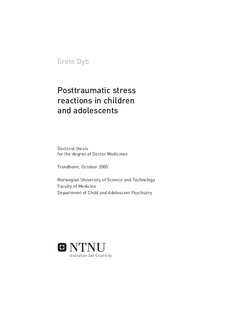| dc.description.abstract | The 1980s mark the beginning of systematic research and theoretical advances in the field of psychic trauma in children. Posttraumatic stress disorder (PTSD) was a diagnosis for adults in the Diagnostic and Statistical Manual of Mental Disorders, DSM-III (American Psychiatric Association, 1980). In a later version, children and adolescents were partially included (American Psychiatric Association, 1987). Since 1980, a range of traumatic events have been identified as having the required stressor characteristics for posttraumatic stress reactions to manifest in children and adolescents.
In this study, the role of the stressor and peritraumatic reactions in PTSD of children and adolescents was studied. In addition, co-existing factors were assessed and related to the development and maintenance of PTSD reactions. A cascade of distressing events described the stressor in children who reported sexual abuse in daycare (paper I), and single-incident events were studied in adolescents (paper III). Subjective reactions during or immediately after the traumatic event, such as intense emotions, physiological arousal, dissociation and having thoughts of intervening, were strongly associated to the subsequent development of PTSD reactions in adolescents. The findings indicate that subjective responses to traumatic events play an important role in PTSD etiology. Objective features of the stressor, such as death or physical injury did not relate significantly to the levels of posttraumatic stress reactions. Half the children exposed to the cascade stressor in the case of alleged child sexual abuse, showed significant levels of PTSD reactions four years later. The objective features of the cascade stressor depended on the reported severity of child sexual abuse as well as media exposure, medical examinations, forensic interviews and the court trial. Children with high levels of PTSD reactions reported more severe CSA and were also more exposed to the media and the court trial, but the tendency was not significant.
Moreover, co-existing factors not related to the traumatic event may play important roles in the development and maintenance of PTSD reactions. After alleged sexual abuse and subsequent distressing events, older children displayed more PTSD reactions than younger children, which may indicate that younger children were more protected from developing distress in this situation. On the other hand, five weeks after a tram car accident, age was negatively associated with the levels of PTSD reactions in a group of children (paper IV). The findings may be due to the diverse nature of the stressors and methodological issues.
Other co-existing factors to PTSD, such as behavior problems in children and adolescents, may represent considerable difficulties in a young person’s life. In the current study, children displayed significant levels of behavioral problems four years after alleged sexual abuse.
The impact on parents and the rest of the child’s family cannot be ignored in the assessment of posttraumatic stress reactions of children and adolescents. In this study, comprehensive assessments were made of the parents’ experiences and levels of distress after alleged sexual abuse of their children. The parents were exposed to a cascade of events, including hearing about the sexual abuse, being involved in the police investigation and the court trial and being exposed in media reports. Four years after the events, elements of the stressor were significantly associated to the level of posttraumatic stress reactions. The findings illustrate how child sexual abuse reports may involve the children’s parents and expose them to high levels of distress over a long period of time.
In addition, interactions in the family may contribute in the development and maintenance of posttraumatic stress reactions in children and adolescents, and impede the healing processes.
After traumatic events in childhood, researchers tend to prefer parental reports of the children’s reactions to spare the children. In this study, children reported significantly higher levels of distress than observed by their parents after a tram car accident (paper IV). These findings indicate that parents unintentionally may bring in a response bias in their reports, which future research and clinical practice should take into account.
The study illustrates that traumatic events are complex experiences involving cognitive and emotional reactions, physiological arousal and dissociation, and that these reactions may induce posttraumatic stress reactions in children and adolescents. The cascade stressor subsequent to alleged sexual abuse of children showed how different elements of the stressor may lead to distress over a long period of time. The distress involved both children and parents in this study. | nb_NO |
| dc.relation.haspart | Dyb, G; Holen, A; Braenne, K; Indredavik, MS; Aarseth, J. Parent-child discrepancy in reporting children's post-traumatic stress reactions after a traffic accident. Nordic Journal of Psychiatry. 57: 339-344, 2003. | nb_NO |
